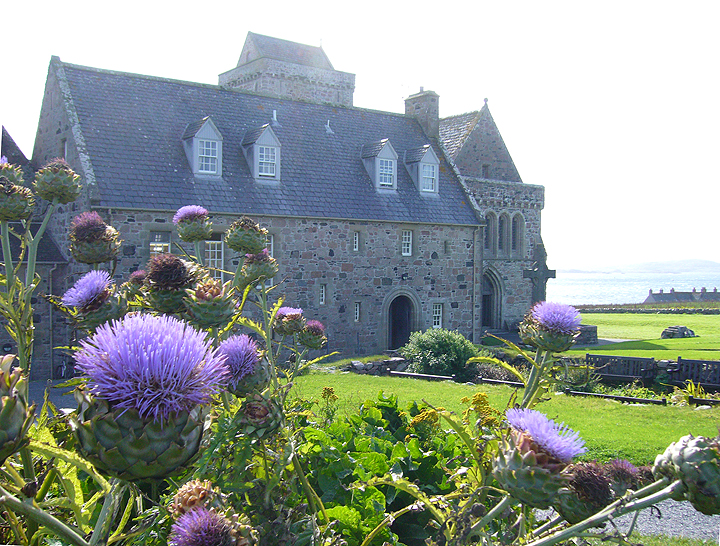spread Christianity in Scotland. The Book of Kells had their origin on Iona, as did the Lindisfarne Gospels.
Later Benedictines established the Abbey and Nunnery on Iona in the 1200s which form the structural shell for the current buildings. The buildings were restored and maintained by the Iona Community established in 1938 by George MacLeod, and presently managed by the National Trust and Historic Scotland.
After a rest and dinner at the hotel, we went to the evening worship and welcome tea at the Abbey. We stumbled back in the rain and the dark. The next day was Sunday so we pressed on to return to the Abbey for worship. The morning service included communion and afterwards we attended an introduction to the aims of the Iona Community.
The rain was so persistent we stopped at the other hotel for scones to sit out the rain. It never stopped that day and the dinner meal there was great, but fortunate for us it was intermittent for the rest of the week with rainbows and sun. There are two hotel guest houses, the Episcopal center and a few bed and breakfast establishments. The Abbey and the MacLeod Center take guests for a loosely programmed week of work and reflection in community. That program is managed by the Iona Community. The island has 100 plus permanent residents and thousands of pilgrim/tourists who come for the day and turn around to make their journey elsewhere.
We are grateful for the preservation and restoration of this very beautiful and historic Christian place. We are grateful our friends Tuey, Randy and Evelyn came with us. We spent a wonderful four days there and would return again to walk and talk and pray, think, read and enjoy weather.
Columba went out from Ireland and Patrick, came to Ireland about 125 years earlier. On an early morning run before the Crumlin Road church Summer Outreach, we drove to Downpatrick and visited the St. Patrick Centre. From the educational display, we learned that Patrick was kidnapped when he was 16 and made a slave in Ireland and tended sheep for six years after which he escaped and went back home to Great Britain. He became a monk and much later felt called to return to Ireland and converted the people to Christianity. Two works remain attributed to Patrick, his Confessions and Letter to Coroticus. He was born sometime around 390 AD came back to Ireland as a Bishop around 435. Two hundred years later mythical Patrick was created by medieval scholars. They turned the humble missionary into a heroic super saint who could banish snakes and perform great miracles. St. Patrick is the most prominent of all the saints but little is known about the true Patrick.
However it is clear that Columba and Patrick were called to live the Christian life. They went out, so many years ago, and impacted our history.
Email: wardstothers@cten.org
Phone: (028) 90 291986 From U.S. 01144.2890.291986
To view the .pdf version with all the photos. Print or email our newsletter
|

